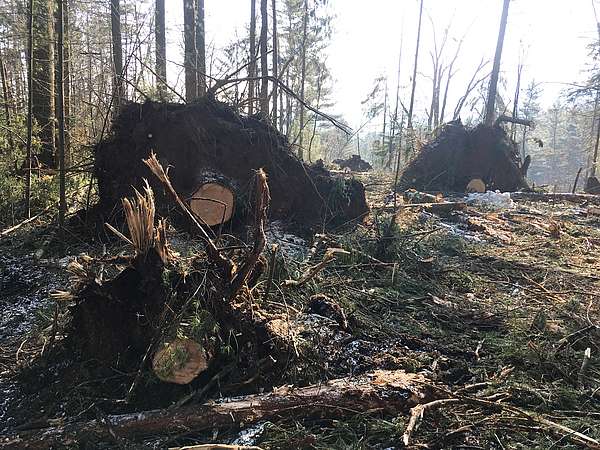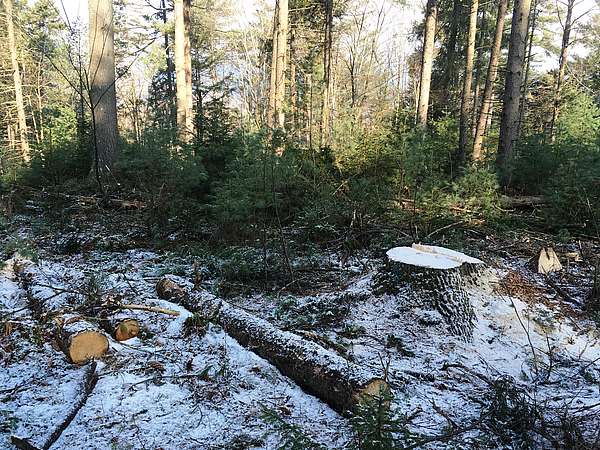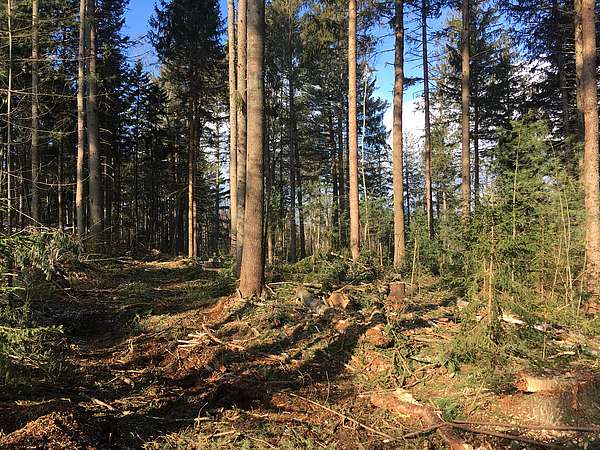It’s been over 20 years since logging equipment was last in Cady Hill Forest. This winter, it was back.
Having to respond to the October 30th wind disturbance at Cady Hill Forest has reminded us that the economic value in trees also has the capacity to help support other uses of the forest that are important to us and come with a price tag – like recreation.
In this case, having the option to salvage and harvest trees at Cady Hill has made what would have been an extremely challenging and expensive recovery much more manageable while achieving other objectives. Elsewhere, a proactive approach to timber management on public lands has the potential to generate revenue that can be intentionally funneled back into access improvements, new trail construction, and critical maintenance. This integrated approach to timber and recreation management has been realized successfully on town and state forests across Vermont for generations.
Although the primary objective of this winter’s logging job at Cady Hill was to clear the tangle of trees that were blocking the property’s 11 miles of trails, the project was intentionally designed to meet other goals as well: managing for high-quality timber, improving tree vigor and growth, and enhancing wildlife habitat quality and diversity. Generally, these objectives were accomplished by removing most - but not all - of the fallen trees and cutting some additional standing low-vigor, high-risk trees. This created a new variety of more complex growing and habitat conditions in a forest that –had been fairly simple and uniform.
What this actually looks like to most eyes – at least initially – is a mess. However, when it comes to logging, there are bad messes and good messes.
At Cady Hill, a good mess has been left behind intentionally by retaining some tree tops, downed logs, and standing dead trees in order to provide cover, perches, and nest sites for birds and other wildlife. The remaining root balls of toppled trees are already improving habitat quality for birds like the Winter Wren that nest in tip-ups and are returning to find lots more nesting options than last season.
Although skid trails where the logging machinery traveled will inevitably be raw and muddy this spring, ruts and erosion have been avoided or minimized throughout the property with careful layout, ditching, and stable stream crossings. Logging equipment crossing some of the recreational trails was unavoidable, but crossings were limited, oriented at right angles to the trails, and done during frozen conditions to minimize damage where possible. Bad messes – such as significant scarring and damage to retained trees and deep rutting or erosion along skid trails that worsens over time – have been avoided through professional planning and oversight by foresters and skilled operation by loggers.
The changes at Cady Hill are dramatic and the impact significant. They will be shocking and disorienting to experience for the first time when your last memory was of a very different forest. This was certainly true for me.
At the same time, I find the changes at Cady Hill exciting and hopeful. They remind me that forests are indeed natural systems where we are not fully in control; we can work with forces at play like windstorms but we cannot stop them. I am eager to see the new growth of tree seedlings and other plants that will take place over the coming years and the response of birds and other wildlife to the changes in the forest. Seeing new cut stumps and skid trails at Cady Hill also makes me proud that Stowe’s conserved lands are contributing to Vermont’s forest product economy. Harvested trees from our town lands are now helping to heat local homes and schools, produce paper, and create lumber for construction projects. I am grateful that the Stowe community is a place where hikers, mountain bikers, loggers, and biologists can find common ground and purpose and where people can tolerate – and perhaps even appreciate – opportunities for traditional and emerging rural economic enterprises to not only coexist, but to support each other.
Although the logging work is now complete, Cady Hill and its trails will continue to be closed this spring for everyone’s safety and in order to let soils dry out and settle.
Loggers, Brian LaFoe and Jed Lipsky, will return in the coming weeks to complete closeout steps including smoothing, seeding, and stabilizing drainage ditches along the skid trails. Last month, professional arborist and logger, Mark Foster, was hired to clear many of the downed trees that were blocking recreational trails outside of the salvage and harvest areas. The Stowe Trails Partnership is planning a carefully coordinated effort to clear, reroute, and rebuild trails across the network over the coming season. This work will take time and a combination of professional trail builder and volunteer work.
If you are eager to help out, please plan to join on the Trail Partnership’s Spring Trail Work Day on Saturday, May 5th. More information at www.facebook.com/StoweTrails Also, stay tuned for upcoming opportunities to learn more about the forestry and logging work, as well as trail recovery efforts, on the ground; we plan to offer at least one more woods tour this spring. In the meantime, thanks for everyone’s continued support, commitment, and patience!


